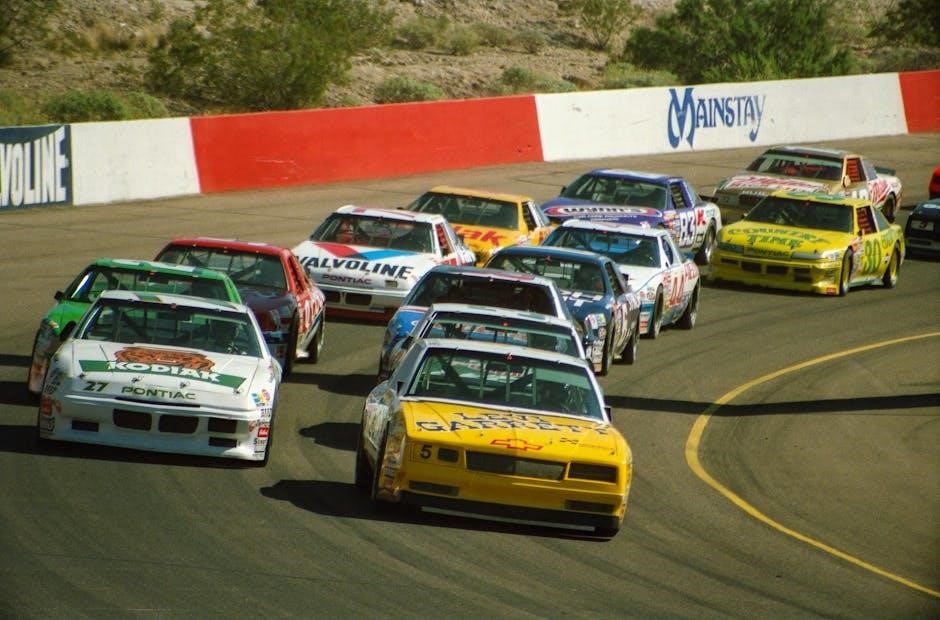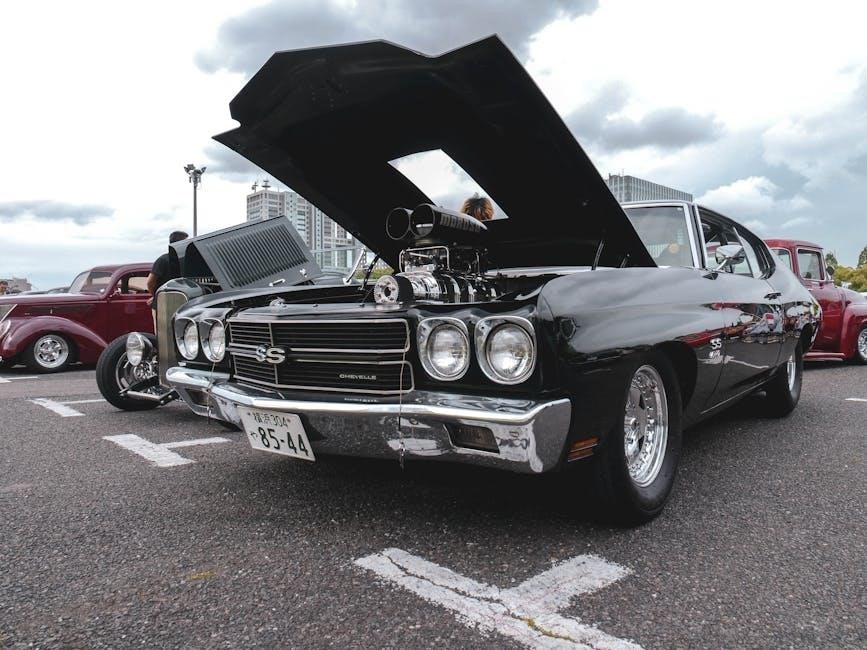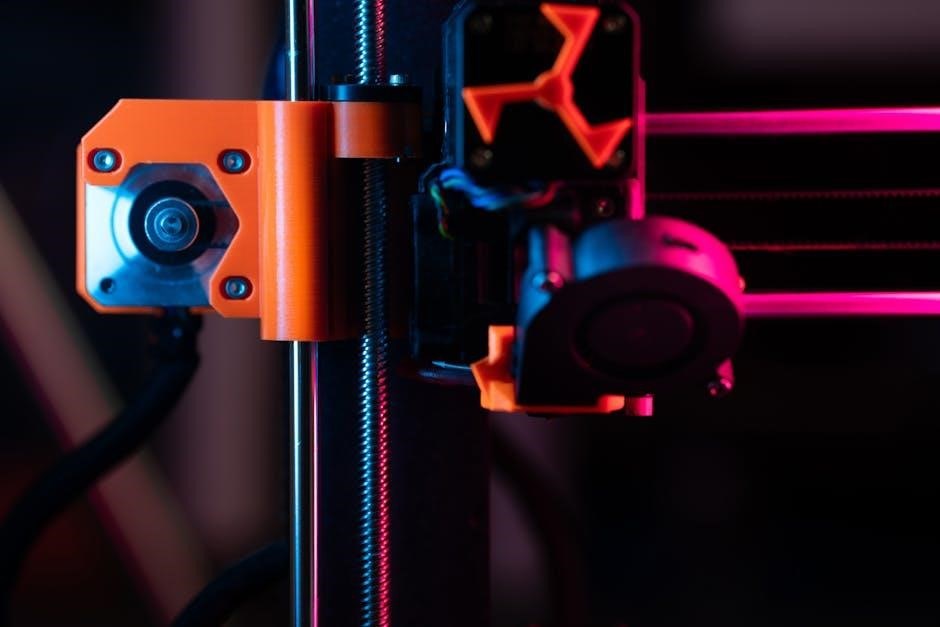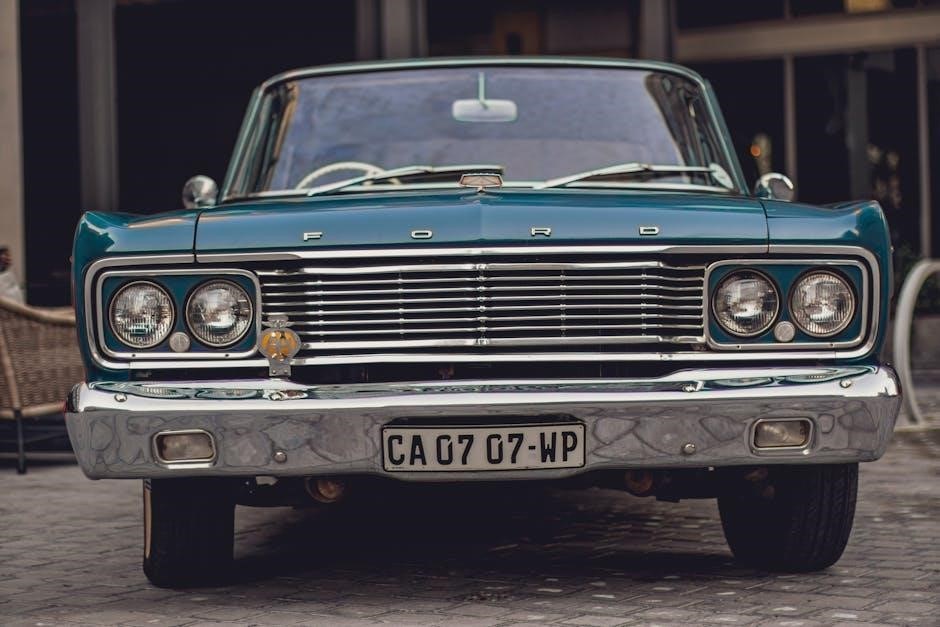This guide provides a comprehensive overview of the Ford 4․6L engine‚ focusing on interchangeability‚ compatibility‚ and key considerations for successful swaps across various Ford platforms․
Overview of the Ford 4․6L Engine
The Ford 4․6L engine‚ part of the Modular V8 family‚ is a versatile powerplant used across various Ford models‚ including the Crown Victoria‚ Mustang‚ and F-150․ Known for its durability and performance‚ the engine features a modular design‚ allowing for easier maintenance and upgrades․ It is available in 2-valve‚ 3-valve‚ and 4-valve configurations‚ with the 3-valve version introduced in 2005 for improved efficiency․ The engine’s compatibility across platforms makes it a popular choice for swaps‚ though differences in heads‚ blocks‚ and wiring require careful consideration․ Its reliability and widespread use have solidified its reputation as a dependable option for both stock and modified applications․
Importance of Engine Interchangeability
Engine interchangeability is crucial for cost-effective upgrades and repairs‚ allowing enthusiasts to source compatible 4․6L engines from various Ford models․ This flexibility reduces reliance on rare or expensive parts‚ making swaps more accessible․ Interchangeability also enables performance enhancements‚ such as upgrading to PI heads for improved compression and power․ However‚ compatibility varies‚ with differences in VIN codes‚ engine blocks‚ and wiring requiring careful planning․ Understanding these factors ensures successful swaps‚ avoiding costly mismatches․ This guide helps navigate these complexities‚ empowering owners to maximize their engine’s potential while minimizing downtime and expenses․
Key Considerations for a Successful Engine Swap
A successful 4․6L engine swap requires careful planning and attention to detail․ Compatibility of components like manifolds‚ mounts‚ and transmissions is essential‚ as mismatches can lead to mechanical issues․ Wiring and ECM reprogramming are critical‚ especially when swapping between different model years or platforms․ Porting and head compatibility must be addressed‚ with PI heads offering improved performance but requiring specific modifications․ Additionally‚ engine block specifications and casting numbers should be verified to ensure a seamless fit․ Proper research and preparation can save time and money‚ ensuring the swap meets performance and reliability goals․

Understanding Ford 4․6L Engine Variants
The Ford 4․6L engine comes in 2-valve‚ 3-valve‚ and 4-valve configurations‚ each offering distinct performance characteristics․ Variations in cylinder heads‚ engine blocks‚ and port designs impact compatibility and power output․
2-Valve vs․ 3-Valve vs․ 4-Valve Engines
The Ford 4;6L engine is available in 2-valve‚ 3-valve‚ and 4-valve configurations‚ each offering unique performance and compatibility traits․ The 2-valve version‚ found in earlier models‚ provides reliable power but lacks the higher RPM efficiency of its 3-valve counterpart․ Introduced in 2005‚ the 3-valve design improves mid-range torque and fuel efficiency‚ making it a popular choice for everyday driving․ The 4-valve variant‚ typically used in high-performance applications‚ delivers superior horsepower and responsiveness due to its advanced cylinder head design․ Understanding these differences is crucial for selecting the right engine for a swap‚ ensuring optimal performance and compatibility with your vehicle․
PI vs․ Non-PI Engine Heads
PI (Performance Improved) and Non-PI engine heads differ significantly in design and performance․ PI heads‚ introduced in later models‚ feature a more efficient port shape and larger combustion chambers‚ enhancing airflow and power․ Non-PI heads‚ found in earlier engines‚ have smaller ports and chambers‚ limiting high-RPM performance․ Swapping Non-PI engines with PI heads requires port reshaping or upgrading to PI-compatible components․ PI heads are cost-effective and readily available‚ making them a popular choice for performance upgrades․ Understanding these differences is essential for ensuring compatibility and maximizing engine potential during a swap․
Engine Block Specifications and Casting Numbers
The Ford 4․6L engine block is available in two primary designs: Romeo and Windsor․ Romeo blocks feature a cast iron construction with a rough texture‚ while Windsor blocks are aluminum and smoother․ Casting numbers like R9040 and W9040 help identify the block type․ These specifications are crucial for compatibility during swaps‚ as they determine mounting points‚ cooling systems‚ and overall fitment․ Understanding these differences ensures proper engine selection and avoids costly modifications․ Always verify casting numbers before purchasing or swapping to guarantee compatibility with your vehicle’s platform and existing components․

Compatibility and Interchangeability
Compatibility and interchangeability of the Ford 4․6L engine depend on VIN codes‚ engine specifications‚ and platform-specific designs․ Engines from 1991-2009 Panther platforms and 1996-2005 models often share interchangeability‚ simplifying swaps across similar vehicles․
VIN Codes and Engine Identification
VIN codes play a crucial role in identifying compatible 4․6L engines‚ particularly for Panther platform vehicles from 1991 to 2009‚ which use the VIN code “W” for gasoline engines․ The Romeo engine‚ a variant of the 4․6L‚ is identified by specific casting numbers and VIN codes‚ differing from other 4․6L engines․ Understanding these codes helps determine interchangeability‚ especially for 1996-2005 models‚ where engine swaps are more straightforward․ Non-PI and PI heads also impact compatibility‚ with PI heads from 1999-and-later models offering improved performance and availability․ Accurate identification ensures a smoother engine swap process‚ avoiding costly mismatches and ensuring optimal performance․
1991-2009 Panther Platform Engine Compatibility
The Panther platform‚ spanning 1991 to 2009‚ utilized the 4․6L engine‚ with specific compatibility tied to VIN codes and engine variants․ The Romeo engine‚ identified by its casting numbers‚ was a common choice for these vehicles․ Engines from 1996 to 2005 are highly interchangeable‚ while earlier models may require modifications․ VIN code “W” denotes a gasoline-powered 4․6L engine‚ aiding in identification․ Compatibility varies across Crown Victoria‚ Grand Marquis‚ and Town Car models‚ with later years offering more flexible swap options․ Proper identification of engine blocks and heads ensures a successful swap‚ maintaining performance and reliability across the Panther platform’s lifespan․
1996-2005 Interchangeability of 4․6 Engines
Engines from 1996 to 2005 are highly interchangeable due to standardized designs and shared components․ The 4․6L engine from this period can be swapped across various Ford models‚ including Crown Victoria‚ Mustang‚ and F-150‚ with minimal modifications․ Key factors like engine blocks‚ cylinder heads‚ and VIN codes determine compatibility․ PI and non-PI heads can be interchanged with port reshaping or upgrades․ The Romeo engine‚ identified by specific casting numbers‚ is a popular choice for swaps․ This era offers flexibility for enthusiasts‚ making it easier to find compatible engines for upgrades or repairs‚ ensuring a smooth transition between models and generations․

Engine Components and Swapping
Engine components like manifolds‚ mounts‚ and transmissions are interchangeable‚ simplifying the swapping process․ Wiring extensions and compatibility checks ensure a smooth transition during engine replacements․
Manifolds‚ Mounts‚ and Transmission Compatibility
Manifolds‚ mounts‚ and transmissions are critical components in a 4․6L engine swap․ The modular design ensures compatibility across various Ford platforms‚ simplifying the process․ However‚ verifying specific part numbers and casting codes is essential to avoid mismatches․ For instance‚ the 4․6L engine from a Crown Victoria may fit a Mustang‚ but exhaust manifolds and engine mounts must be checked for compatibility․ Additionally‚ transmissions like the 4R70W or 4R75E are often compatible‚ but proper alignment and wiring are necessary․ Always consult VIN codes and engine specifications to ensure a seamless swap and optimal performance․
PI Heads vs․ Non-PI Heads: What You Need to Know
PI (Performance Improved) heads differ significantly from Non-PI heads‚ primarily in port shape and combustion chamber volume․ PI heads offer improved airflow and higher static compression‚ enhancing performance․ Swapping Non-PI engines with PI heads requires modifications‚ such as port reshaping or using compatible intake manifolds․ While PI heads are cost-effective and readily available‚ ensuring compatibility with your engine block and intake system is crucial․ This swap can significantly boost power but demands careful planning to avoid compatibility issues․
Reshaping Ports for Compatibility
Reshaping ports is a viable solution for achieving compatibility between PI and Non-PI heads․ This process involves modifying the intake ports to match the shape and size of the desired head configuration․ While it can be labor-intensive‚ port reshaping ensures proper airflow and combustion efficiency․ However‚ it requires precision and expertise to avoid damaging the engine․ Alternatively‚ swapping to PI heads from later models is often more practical‚ as they offer improved performance and are readily available․ This approach eliminates the need for extensive port modifications‚ making it a cost-effective solution for many enthusiasts and mechanics․

Cylinder Heads and Performance
Cylinder head design significantly impacts performance․ PI heads offer improved airflow and higher compression‚ enhancing power and efficiency compared to Non-PI heads‚ making them a popular upgrade․
Static Compression and Combustion Chamber Volume
Static compression ratio and combustion chamber volume play crucial roles in engine performance․ The 4․6L engine’s compression ratio varies slightly between PI and Non-PI heads due to differences in combustion chamber design․ PI heads typically have smaller combustion chambers‚ which increase static compression‚ leading to better thermal efficiency and power output․ This makes PI heads a desirable upgrade for enthusiasts seeking improved performance without significant modifications․ Understanding these specifications is essential for maintaining optimal engine operation during swaps or upgrades‚ ensuring compatibility and maximizing potential gains in horsepower and torque․
Upgrading to PI Heads for Improved Performance
Upgrading to PI heads significantly enhances performance by increasing static compression and improving combustion efficiency․ PI heads feature smaller combustion chambers compared to Non-PI heads‚ which boosts power output and thermal efficiency․ However‚ their unique port shape requires compatibility checks with your engine․ For optimal results‚ ensure your intake manifold and headers align with PI head specifications․ Enthusiasts often prefer this upgrade for its noticeable performance gains without major engine modifications․ Always verify compatibility and consider professional installation for the best results․
Cost and Availability of PI Heads
PI heads are generally affordable and widely available‚ making them a cost-effective upgrade for 4․6L engine swaps․ Sourced from 1999-and-later models‚ these heads are often found in junkyards or online marketplaces at reasonable prices․ Costs vary depending on condition‚ with used heads starting around $300-$500․ New or refurbished options are pricier but offer better reliability․ Availability is high due to the popularity of 4․6L engines in Ford vehicles like the Mustang and Crown Victoria․ This accessibility makes upgrading to PI heads a practical choice for enthusiasts seeking improved performance without breaking the bank․ Always inspect for damage or wear before purchasing․

Engine Management and Wiring
Engine management involves using the 4․6 CPS and Ford Racing 9mm wires‚ while wiring extensions and ECM reprogramming ensure compatibility during swaps‚ maintaining optimal performance and reliability․
Using the 4․6 CPS and Ford Racing 9mm Wires

The 4․6L crankshaft position sensor (CPS) is crucial for accurate engine timing‚ ensuring smooth operation during swaps․ Ford Racing 9mm spark plug wires enhance ignition performance‚ reducing interference and boosting power․ These components are compatible with various 4․6L engines‚ making them ideal for swaps․ Proper installation ensures reliable engine function and prevents misfires․ Upgrading to these components is a cost-effective way to improve performance and reliability in modified engines․ They are widely available and recommended for their durability and compatibility across different Ford platforms․
Extending Wiring for Engine Swaps
When performing a 4․6L engine swap‚ wiring modifications are often necessary to ensure compatibility․ Extending the wiring harness allows proper connection of components like the ECM‚ sensors‚ and ignition system․ This step is critical for maintaining engine functionality and preventing electrical issues․ Use high-quality wiring materials to avoid signal degradation․ Professional installation is recommended to ensure reliability․ Proper wiring extension ensures seamless communication between engine components and the vehicle’s systems‚ making the swap more efficient and less prone to electrical faults․ This step is essential for a successful and trouble-free engine swap experience․
ECM Reprogramming and Engine Compatibility
ECM reprogramming is crucial for ensuring compatibility during a 4․6L engine swap․ The Engine Control Module must be calibrated to recognize the new engine’s specifications‚ such as fuel injection timing and ignition curves․ Without proper reprogramming‚ the engine may run inefficiently or experience performance issues․ A skilled technician can adjust the ECM’s software to match the swapped engine’s characteristics‚ ensuring optimal performance and reliability․ This step is vital for achieving seamless integration and maximizing the engine’s potential in its new application․ Always use compatible ECM software to avoid conflicts and maintain proper engine operation․

Transmission and Exhaust Considerations
Transmission compatibility is critical for a smooth 4․6L engine swap․ Ensure the transmission matches the engine’s specifications for proper gear ratios and torque handling․ Exhaust systems may require modifications to fit the new engine’s configuration‚ including header and manifold compatibility․ Proper alignment and sizing of exhaust components are essential for optimal performance and to avoid restrictions․ Always verify header and intake compatibility to maintain efficient airflow and prevent potential engine damage․ These considerations ensure a seamless integration of the engine with the vehicle’s existing systems․
Transmission Compatibility with 4․6 Engines
Transmission compatibility is a critical factor when swapping a 4․6L engine․ The 4․6L engine is designed to work with specific transmissions‚ such as the 4R70W or 4R75E‚ which are commonly used in Ford vehicles․ These transmissions are engineered to handle the torque and horsepower output of the 4․6L engine․ However‚ compatibility can vary depending on the vehicle platform and model year․ For example‚ the E40D transmission may require modifications to work with a 4․6L engine‚ while the 5R110W transmission is generally compatible with later-model 4․6L engines․ Always verify transmission specifications and ensure proper wiring and control systems are in place for a seamless swap․
Exhaust System Modifications for Engine Swaps
When performing a 4․6L engine swap‚ exhaust system modifications are often necessary to ensure proper fitment and performance․ The exhaust ports on the engine may require resizing or reshaping to match the existing exhaust system․ Headers designed for the 4․6L engine are typically compatible‚ but modifications may be needed to align with the vehicle’s exhaust layout․ In some cases‚ custom exhaust work or adapter plates may be required to achieve a proper seal and optimal flow․ Always verify compatibility between the engine’s exhaust ports and the vehicle’s exhaust system to avoid leaks or performance issues after the swap․
Header and Intake Compatibility
Ensuring header and intake compatibility is crucial for a successful 4․6L engine swap․ The intake manifold must align with the engine’s port configuration‚ particularly when switching between PI and non-PI heads․ Headers designed for the 4․6L engine typically fit well‚ but modifications may be needed for specific vehicle applications․ Port reshaping or adapter plates can help achieve compatibility‚ especially when integrating PI heads onto a non-PI engine․ Proper alignment ensures optimal airflow and performance‚ while preventing potential leaks or fitment issues․ Always verify compatibility before installation to maintain engine efficiency and reliability․
Vehicle-Specific Swap Guides
This section provides detailed guides for swapping the 4․6L engine into popular Ford models‚ including the Crown Victoria‚ Mustang‚ F-150‚ and Lincoln‚ ensuring compatibility and performance․
Ford Crown Victoria Engine Swap Guide
The Ford Crown Victoria‚ part of the Panther platform‚ is a popular candidate for 4․6L engine swaps due to its robust design and compatibility with Romeo engines․ Swapping a 4․6L into a Crown Victoria requires careful consideration of VIN codes and engine specifications․ The 4․6L engine from 1992-2012 models is highly compatible‚ with minimal modifications needed for installation․ Key considerations include ensuring the correct engine block and head combination‚ as well as verifying wiring and ECM compatibility․ The Crown Victoria’s large engine bay accommodates the 4․6L modular V8 seamlessly‚ making it a favored choice for enthusiasts seeking reliable performance without extensive fabrication․
Ford Mustang Engine Swap Guide
Swapping a 4․6L engine into a Ford Mustang offers a blend of modern power and classic styling․ The 4․6L modular V8‚ particularly the 2-valve and 3-valve variants‚ is a popular choice due to its compatibility with the Mustang’s engine bay․ Key considerations include ensuring the correct wiring harness and ECM reprogramming to match the engine specifications․ The 4․6L CPS and Ford Racing 9mm wires are often recommended for reliable ignition․ Additionally‚ minor modifications to the intake and headers may be necessary for optimal performance․ This swap is ideal for enthusiasts seeking a balance of power and reliability in their Mustang build․
Ford F-150 Engine Swap Guide
Swapping a 4․6L engine into a Ford F-150 is a popular modification due to its compatibility and reliability․ The modular design of the 4․6L engine makes it a straightforward swap for many F-150 models‚ particularly those from 1997 to 2003․ Key considerations include ensuring the correct wiring harness and ECM compatibility‚ as well as verifying transmission and exhaust system compatibility․ The 4․6L engine’s durability and power output make it an excellent choice for F-150 owners seeking improved performance without major modifications․ This swap is ideal for those looking to enhance their truck’s capabilities while maintaining reliability and ease of installation․
Lincoln and Mercury Engine Swap Guide
The 4․6L engine is a popular choice for Lincoln and Mercury models due to its modular design and compatibility․ Swapping a 4․6L into these vehicles requires careful consideration of VIN codes and engine specifications․ Ensure the engine’s casting numbers match the vehicle’s requirements‚ and verify compatibility with manifolds‚ mounts‚ and wiring․ The Panther platform’s 4․6L engines are often interchangeable with Lincoln and Mercury models‚ offering a cost-effective upgrade․ Proper ECM reprogramming and wiring modifications are essential for seamless integration․ This swap is ideal for enhancing performance while maintaining reliability‚ making it a favored option among enthusiasts of these classic models․
Troubleshooting and Common Issues
Common issues include engine knock‚ oil pressure problems‚ and compatibility errors․ Address these by identifying worn components‚ ensuring proper ECM reprogramming‚ and verifying wiring connections for optimal performance․
Identifying Engine Knock and Oil Pressure Issues
Engine knock and oil pressure issues are common challenges during 4․6 engine swaps․ Knocking sounds often indicate worn piston rings or cylinders‚ while low oil pressure may point to a faulty pump or clogged filter․ Monitoring oil pressure regularly is crucial‚ as consistent low readings can signal internal engine wear․ Addressing these issues early prevents costly damage․ Ensure proper ECM reprogramming to maintain accurate oil pressure readings and engine performance․ If a knock persists‚ inspect the combustion chamber and consider replacing damaged components to avoid further deterioration․ Always verify wiring connections and sensor functionality to rule out false readings․
Resolving Compatibility Problems
Compatibility issues during a 4․6 engine swap often arise from mismatched components like manifolds‚ mounts‚ or wiring․ To resolve these‚ ensure all parts are sourced from compatible models․ For instance‚ PI heads require specific intake manifolds‚ while non-PI setups need different configurations․ Extending wiring harnesses and reprogramming the ECM can address electrical incompatibilities․ Additionally‚ verifying transmission and engine block casting numbers ensures proper fitment․ Consulting forums or guides specific to your vehicle‚ such as the Ford F-150 or Crown Victoria‚ can provide tailored solutions․ Always cross-reference VIN codes and engine specifications to minimize issues and ensure a seamless swap․
Addressing Wiring and ECM Challenges
Wiring and ECM issues are common during 4․6 engine swaps due to differences in engine configurations and vehicle platforms․ The 4․6 CPS and Ford Racing 9mm wires are often used to resolve ignition-related problems․ Extending wiring harnesses may be necessary to accommodate the new engine setup; ECM reprogramming is critical to ensure compatibility with the swapped engine‚ especially when moving between PI and non-PI configurations․ Custom tuning can optimize performance and prevent issues like engine knock or oil pressure problems․ Always consult specific guides or forums for your vehicle to address wiring and ECM challenges effectively․

Resources and Communities
Online forums like CrownVic․net and F150online Forums offer valuable guides and troubleshooting tips․ Hot Rod Magazine and Lethal Performance provide expert insights and detailed engine swap information․
Recommended Forums and Communities
Forums like CrownVic․net and F150online Forums are excellent resources for Ford 4․6 engine swap discussions․ These communities offer detailed guides‚ troubleshooting tips‚ and real-world experiences; Additionally‚ Hot Rod Magazine and Lethal Performance provide expert insights and technical articles․ Specialized Facebook groups and Reddit communities‚ such as r/FordPerformance‚ also serve as hubs for enthusiasts to share knowledge and solutions․ These platforms are invaluable for identifying compatible parts‚ resolving issues‚ and gaining expert advice from experienced mechanics and DIYers․ Engaging with these communities can significantly simplify the engine swap process and ensure long-term reliability;

Useful Articles and Guides
Hot Rod Magazine offers a detailed guide on building the Ford 4․6L engine‚ emphasizing port reshaping and PI head upgrades․ Lethal Performance provides a comprehensive overview of the 4․6 Modular V8‚ covering its design and performance potential․ Additionally‚ the “Ford 4․6L 2/3/4-valve V8 Engine Specs” article outlines technical specifications and common issues․ BigNSlow’s “4․6 engine compatibility guide” is a must-read for understanding interchangeability across platforms․ These resources‚ along with forums like CrownVic․net‚ offer troubleshooting tips‚ step-by-step instructions‚ and expert advice‚ making them indispensable for enthusiasts and professionals alike․ They cover everything from engine design to real-world swap solutions․
Expert Tips and Recommendations
Experts recommend using the 4․6 CPS and Ford Racing 9mm wires for reliable ignition․ Reshaping ports for compatibility is a cost-effective solution‚ as highlighted in Hot Rod Magazine․ Upgrading to PI heads from 1999-and-later models boosts compression and performance․ Extending wiring for engine swaps ensures proper ECM communication․ Always verify VIN codes for engine compatibility‚ especially for Panther platforms․ Consulting forums like CrownVic․net provides valuable insights and troubleshooting tips․ Prioritize checking casting numbers and combustion chamber volumes for optimal performance․ These tips ensure a smoother swap process and maximize the potential of your 4․6L engine․
The Ford 4․6L engine offers modular design and easy swapping potential‚ making it a cost-effective choice for enthusiasts․ Community support and guides enhance successful modifications and upgrades․
Final Thoughts on 4․6 Engine Interchange
The Ford 4․6L engine’s modular design and extensive compatibility make it a versatile choice for swaps․ With proper planning and research‚ enthusiasts can achieve significant performance gains․ PI heads and updated components are key for modernizing older engines․ Community forums and guides provide invaluable resources for overcoming challenges․ While some modifications require expertise‚ the 4․6L remains a cost-effective and rewarding platform for engine swaps․ Its durability and wide availability ensure it will remain popular among Ford enthusiasts for years to come․
Future of 4․6 Engine Swaps and Modifications
The Ford 4․6L engine’s future in swaps and modifications remains bright‚ driven by its durability and widespread availability․ Enthusiasts continue to explore innovative ways to enhance performance‚ with PI heads and ECM reprogramming leading the way․ As technology advances‚ expect more efficient and powerful builds․ The modular design allows for adaptability‚ making it a favorite for both classic and modern applications․ Community support and forums will play a crucial role in sharing knowledge and inspiring new projects․ With its rich history and versatility‚ the 4․6L engine will remain a cornerstone of Ford performance for years to come․



